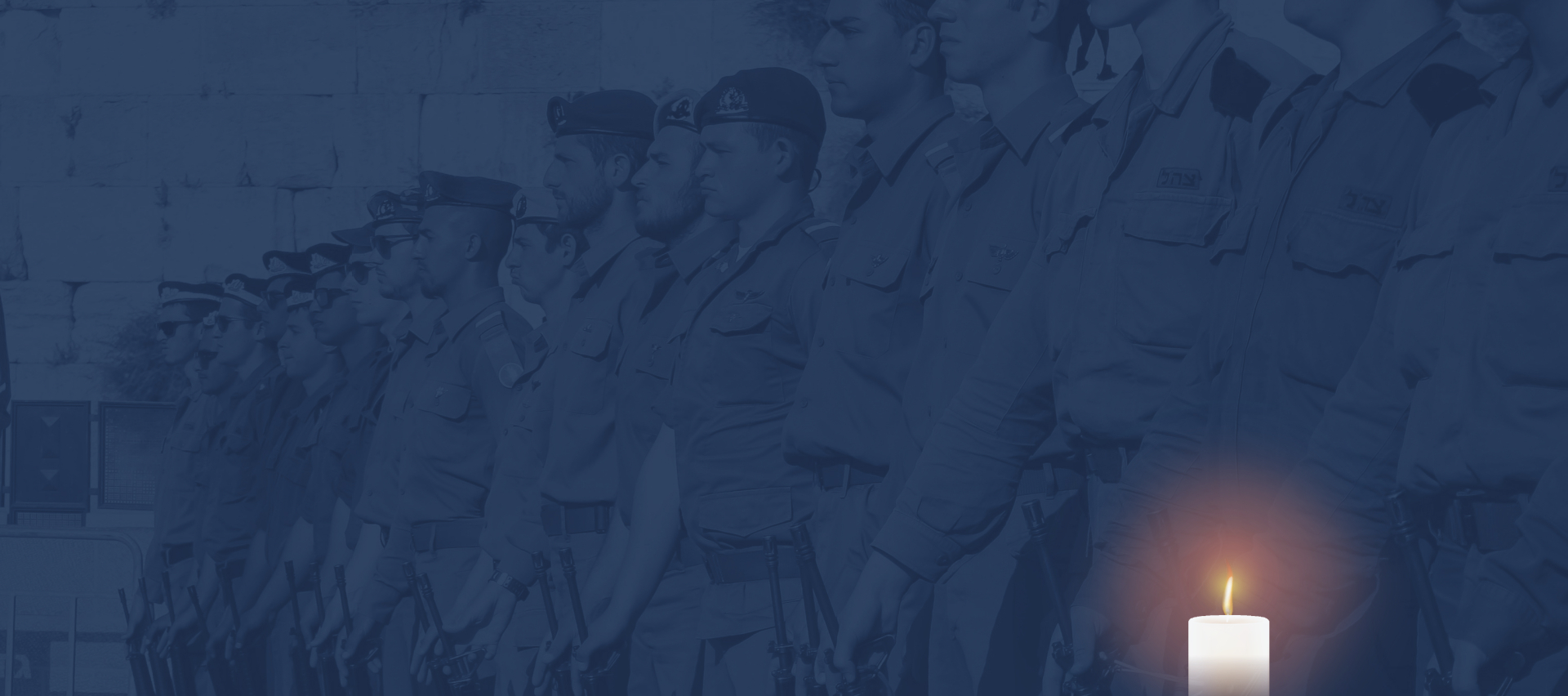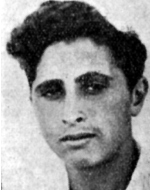,אֵ-ל מָלֵא רַחֲמִים, שׁוכֵן בַּמְּרומִים, הַמְצֵא מְנוּחָה נְכונָה
,עַל כַּנְפֵי הַשְּׁכִינָה בְּמַעֲלות קְדושִׁים, טְהורִים וְגִבּורִים
כְּזֹהַר הָרָקִיעַ מַזְהִירִים, לְנִשְׁמות חַיָּלֵי צְבָא הֲגָנָה לְיִשְׂרָאֵל



Morshchik, Zeev (Wolf)
Zeev, son of Yentil and Yosef, was born in October 1931 in Kaunas (Kovno), the capital of Lithuania, and received a popular education from the end of the First World War until 1940. Lithuania was an independent state, Cultural, cultural, and cultural significance of Eastern European Jewry, and as the focus of extensive Zionist activity.40 In 1940, Lithuania was annexed to the Soviet Union, when the Hebrew educational institutions were closed down and most of the cultural and social organizations were liquidated. Jews managed to escape into Soviet territory prior to the occupation, and immediately afterwards a ghetto was established in Slobodka, a suburb of Kovno. In the summer of 1941, about 10,000 Jews were murdered in Kaunas, and about 30,000 Jews were murdered in Kovno in August 1941. In the following months more than 10,000 Jews were murdered and the rest were forced to work. On July 8, 1944, as the Russian Red Army approached Kovno, the authorities began to transfer the Jews to the concentration camps of Dachau, Kaufering and Stutthof in Germany. Until the end of the war, most of the Jews of Lithuania perished. Ze’ev was imprisoned with his family in the Kovno ghetto. In 1944, with the liquidation of the ghetto, his family was brought on a train to Germany. During the terrible journey, the train of mothers and children was removed from the Stutthof camp, and Ze’ev was forced to leave his mother and his little sister. Together with his father, he continued to the Dachau camp in Germany, where the older children were brutally separated. Ze’ev never saw his father again, who had perished there. Every day Ze’ev would go to work in Dachau, and despite the difficulties he managed to hold out. After a while he was sent with a group of 130 children to the Auschwitz extermination camp, where they were forced to work in hard labor and under inhuman conditions. “I remember our first meeting in the Auschwitz concentration camp, when I arrived from Poland and met with Ze’ev and another fifty young men his age from Lithuania,” relates a friend about his meeting with Zeev in the camp. It was a night of fate, the night that determined our lives then. From within the Lithuanian society, it was possible to recognize Ze’ev as active and provide a spirit for the continuation of life. The next day we were transferred to a labor camp and we began to get along. Ze’ev was among the first volunteers to leave for work. Every evening when he returned home he shared the bread he had made with his friends. There were difficult and bitter times, many of us gave up on life, but Ze’ev always claimed, ‘We will avenge them, do not despair, guys! “With the start of the Soviet army’s offensive in the direction of Krakow and Auschwitz in mid-January 1945, the Nazis began a hasty retreat from Auschwitz, and the 66,000 prisoners, mostly Jews, were marched in long columns in a grueling march through the so-called” Death March. ” Wolf was sent on a death march to Gonskirchen in Austria, where he remained until the day of liberation – May 5, 1945. One of the group’s children who were brought to Dachau remained only four, and Zeev among them. His family and relatives, but it turned out that not one of them survived, and Ze’ev joined the hachshara that set out on its way On the “Bericha” route, traveled to Italy where he and hundreds of other Holocaust survivors were collected by Jewish Brigade soldiers, who were housed in a farm that had previously been an Italian Fascist youth farm and served as a shelter for hundreds of Jewish youth. To Palestine in February 1947Born on the ship “Chaim Arlosoroff”. The ship left Sweden on January 1, 1947, carrying 664 Ma’apilim – most of them women survivors of concentration camps, and some of the Hechalutz members from Denmark and Sweden. When she arrived at the port of La Haber in France, hundreds more immigrants boarded her. The harsh weather conditions forced the ship to wander between the ports of Algiers and Tunis until it reached another gathering point in the port of Metaponto, Italy, where another 734 immigrants, including Ze’ev, boarded the ship. From there, Haim Arlosoroff continued on her way to the shores of the country. But British destroyers who attacked it caused a change in the plan, and the ship turned to Haifa. The British boarded the ship, and in a difficult battle on board, victims on both sides fell. At the end, 1,348 illegal immigrants were arrested and sent to the Cyprus deportees’ camp. After spending six months in Cyprus, Ze’ev managed to reach Eretz Israel and join a “Youth Aliyah” training group in Ruppin village in the Lev of the Beit She’an valley. He worked there as a fisherman. In 1948, during the War of Independence, Ze’ev left the army and joined the army. “Ze’evi was one of the first to enlist in the army, leaving the company and heading for another road, hoping that with the end of the war,” he said, “there was a time when the guns were heard from far away and our enemies harassed our peaceful settlements. The battles and the victory will return to the fold of society and will continue to weave together the dream of creation and settlement. Ze’ev served in Battalion 13 in the Golani Brigade, the No. 1 Brigade in the Haganah. He participated in the “Triangle” battles in the central region and then went down with his unit to the Negev. During the days of freedom he would come to the youth group and would tell a lot about the life of the army. His stories were full of enthusiasm, stories of a man ready for anything. In December 1948 Ze’ev participated in Operation Horev. Operation Horev (also known as Operation Ein, in the name of Gaza, Auja and Islog), the largest of the IDF’s operations during the War of Independence, took place during the last stages of the war. It was intended to destroy the remnants of the Egyptian invasion army, to expel it from Israel and to force the Egyptians to start negotiations for a truce. The operation, commanded by Yigal Allon, his partner in the forces of several combat brigades, was brought down from areas where the campaign was quiet. The operation began on December 22, 1948 with the bombing of Egyptian army concentrations and the deception of the eastern wing of the front, towards the Gaza Strip. Later, the main effort moved with two arms towards Auja (Nitzana). On the night of December 21, 1948, Golani forces took control of the 86th post north of Khan Yunis, threatening the road and the railway, and gave the impression that the intention was to cut off the Egyptian forces in the Gaza Strip. The Egyptians reacted with an attack on Gaza with the help of artillery and armor, and under the pressure of the enemy the Golani fighters were forced to retreat. In this battle fell wolf. Ze’ev was seventeen years old when he fell. Was first declared missing, and after his body was found he was buried in the borders. After a while he was put to rest in the cemetery at Kibbutz Ze’elim, where members of his training group settled. During Operation Horev, an attempt was also made to liquidate the Falluja pocket, which had an Egyptian force, but the failure of the attack on Iraq prevented it. Although not all the targets of the operation were achieved, the Israeli forces continued to advance and even penetrated into Sinai. The Egyptian system collapsed and the entire Egyptian army in the Gaza Strip was besieged. Following the invasion of Sinai, heavy political pressure was exerted on Israel and it was required to withdraw, but the threat of disengagement did its job, and on January 6, 1949, Egypt announced its agreement to open negotiations with Israel. The next day, the fire stopped on the southern front, and thus endedFighting on the Egyptian front. This hero is a “last scion”. The survivors of the Holocaust are survivors of the Holocaust who survived the last remnant of their nuclear family (parents, brothers, sisters, sons and daughters) who experienced the Holocaust in the ghettos and / or concentration camps and / or in hiding and hiding in territories occupied by the Nazis and / Or in combat alongside members of the underground movements or partisans in the Nazi-occupied territories who immigrated to Israel during or after World War II, wore uniforms and fell in the Israeli army.

